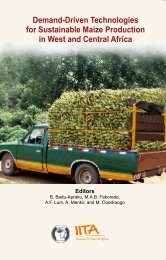Impact of cowpea breeding and storage research in Cameroon - IITA
Impact of cowpea breeding and storage research in Cameroon - IITA
Impact of cowpea breeding and storage research in Cameroon - IITA
You also want an ePaper? Increase the reach of your titles
YUMPU automatically turns print PDFs into web optimized ePapers that Google loves.
Cowpea postharvest <strong>and</strong> socioeconomic studies<br />
Research <strong>and</strong> extension costs<br />
Allocation <strong>of</strong> <strong>research</strong> <strong>and</strong> extension costs is one <strong>of</strong> the most difficult parts <strong>of</strong> economic<br />
impact assessment. The allocation <strong>of</strong> such resources is seldom as clear as the theory suggests.<br />
A key problem is the cumulative nature <strong>of</strong> science. Scientific discoveries today<br />
are built on the <strong>research</strong> <strong>of</strong> the past <strong>and</strong> are the foundation <strong>of</strong> future work. An additional<br />
problem is the broad responsibility <strong>of</strong> most public sector agricultural <strong>research</strong> organizations.<br />
A team, such as the Purdue/IRAD group, is seldom able to focus exclusively on a<br />
narrow set <strong>of</strong> problems, but must respond to producer <strong>and</strong> consumer concerns on a wide<br />
range <strong>of</strong> issues.<br />
In allocat<strong>in</strong>g costs, the cumulative nature <strong>of</strong> science is dealt with follow<strong>in</strong>g the logic<br />
suggested by Masters et al. (1996). All costs related to decisions that were already made<br />
when the CRSP <strong>and</strong> IRA decided to <strong>in</strong>itiate <strong>cowpea</strong> <strong>storage</strong> <strong>research</strong> are considered sunk<br />
costs <strong>and</strong> not charged to the project. Thus, costs <strong>in</strong>curred by <strong>IITA</strong> <strong>in</strong> develop<strong>in</strong>g the genetic<br />
materials that became part <strong>of</strong> the parentage <strong>of</strong> the new CRSP varieties are not charged<br />
to the Purdue/IRAD project. Similarly, costs <strong>in</strong>curred by CRSP <strong>and</strong> other organizations<br />
<strong>in</strong> develop<strong>in</strong>g <strong>and</strong> extend<strong>in</strong>g BR1 <strong>and</strong> BR2 are not charged to the <strong>storage</strong> project even if<br />
BR1 <strong>and</strong> BR2 were among the parents <strong>of</strong> the new varieties, <strong>and</strong> even if the extension <strong>of</strong><br />
BR1 <strong>and</strong> BR2 created a precedent that other new varieties can follow.<br />
The pr<strong>in</strong>cipal use <strong>in</strong> allocation <strong>of</strong> costs is that the <strong>in</strong>tellectual debt to previous <strong>research</strong>ers<br />
is acknowledged, but the cost <strong>of</strong> previous <strong>research</strong> is not added <strong>in</strong>. Similarly, benefits<br />
<strong>of</strong> the project for future <strong>research</strong> are discussed, but not deducted from the <strong>research</strong> <strong>and</strong><br />
extension costs. The benefits <strong>of</strong> the “sweet <strong>cowpea</strong>” variety that was discovered dur<strong>in</strong>g<br />
the development <strong>of</strong> the new varieties are not <strong>in</strong>cluded <strong>in</strong> this analysis.<br />
The diverse responsibilities <strong>of</strong> many agricultural <strong>research</strong>ers are <strong>of</strong>ten more difficult<br />
to deal with than previous <strong>research</strong> <strong>and</strong> extension. Often there is no good way to allocate<br />
time <strong>and</strong> resources. Field trials may be done at the same site <strong>and</strong> cared for by the same<br />
technicians. A computer <strong>and</strong> s<strong>of</strong>tware purchased by one organization is also used <strong>in</strong>cidentally<br />
to analyze data from a related effort. For example, after the CRSP collaboration<br />
with IRAD was refocused on <strong>storage</strong>, some effort cont<strong>in</strong>ued on the previous agronomy<br />
<strong>research</strong>, especially <strong>in</strong> the first few years <strong>of</strong> the <strong>storage</strong> effort. For this analysis all costs<br />
<strong>in</strong>curred by CRSP <strong>in</strong> <strong>Cameroon</strong> <strong>and</strong> for <strong>Cameroon</strong>, <strong>and</strong> by IRAD for CRSP collaboration<br />
are treated as be<strong>in</strong>g for development <strong>of</strong> the postharvest technologies <strong>and</strong> the new varieties.<br />
It is acknowledged that this probably overstates the cost <strong>of</strong> <strong>research</strong>, but given the lack <strong>of</strong><br />
<strong>in</strong>formation on <strong>research</strong>er time <strong>and</strong> resource allocation it is the only practical solution.<br />
Bean–Cowpea CRSP expenditures are taken from account<strong>in</strong>g records at Purdue University<br />
<strong>and</strong> at the CRSP Management Office at Michigan State University. The CRSP amounts<br />
represent two categories <strong>of</strong> expenditure: those <strong>in</strong> <strong>Cameroon</strong> by CRSP <strong>and</strong> by IRAD <strong>and</strong><br />
those made <strong>in</strong> the US explicitly for IRAD. A typical example <strong>of</strong> the “for <strong>Cameroon</strong>”<br />
expenditure is the purchase <strong>of</strong> scientific equipment <strong>in</strong> the US for shipment to <strong>Cameroon</strong>.<br />
Expenditure for short-term tra<strong>in</strong><strong>in</strong>g is <strong>in</strong>cluded. Long-term tra<strong>in</strong><strong>in</strong>g typically has objectives<br />
beyond the development <strong>of</strong> specific technology <strong>and</strong> is not <strong>in</strong>cluded <strong>in</strong> <strong>research</strong> costs for<br />
this analysis. The CRSP is a collaboration with benefits expected on both sides. The US<br />
costs are assumed to be paid for by US side benefits. The IRAD costs are those reported<br />
by the Institute to the CRSP as their contribution to the overall <strong>cowpea</strong> effort.<br />
In <strong>Cameroon</strong>, the Purdue/IRAD team worked closely with the National Cereals<br />
Research <strong>and</strong> Extension (NCRE) project. This occurred <strong>in</strong> particular with the on-farm<br />
418
















